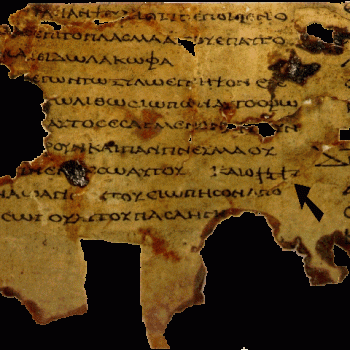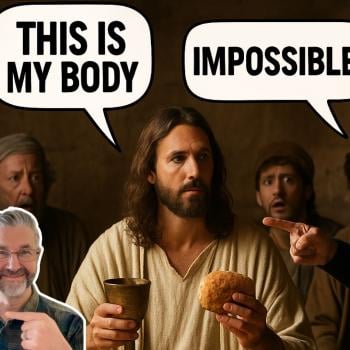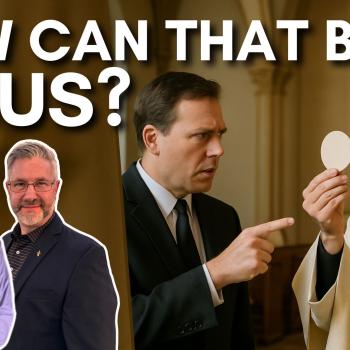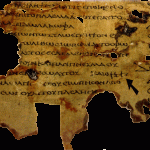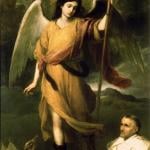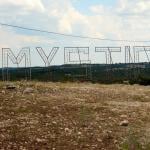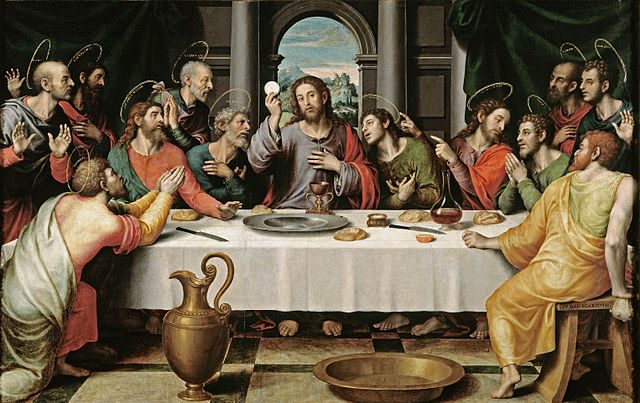
(9-12-05)
***
A Lutheran historian whom I debated, submitted the odd scenario of having to believe that no Church father before St. Cyprian really taught what he did (not even in kernel form) regarding the Eucharist, and then somehow the Cyprianic view (for some strange reason that we are not told) overwhelmed all others and became the status quo (and involved inherent blasphemies and outrageous perversions of true eucharistic doctrine). These corruptions would have to wait for “Super-Fathers” Luther and Calvin to arrive on the scene, to denounce the status quo and received tradition, and help usher the Church back to the true gospel, which — so they endlessly informed their followers — had been obscured in a sacerdotal, idolatrous haze for the previous thousand or so years.
In my opinion, this outlook is not only implausible; it also trivializes and cheapens the necessary, remarkable theological groundwork of the Church fathers. It requires one to interpret their legacy as a chaotic mess, often teetering on the edge of severe heterodoxy, or indeed, crossing over into it. Rather than take them for what they are, it too quickly superimposes (or presupposes) later theology which is arguably itself heterodox (in this case, Lutheranism, vis-a-vis the Sacrifice of the Mass). But I am getting ahead of myself.
On the whole, patristic theology develops consistently, in one direction, and culminates in the fully developed Catholic Church. Protestants, it seems to me, must deny that this was what happened in history. they have to either deny the validity of development of doctrine itself, or argue that the consistent developments all went in the direction of Protestantism, while the corrupt strains of thought formed medieval and modern Catholicism. This is no easy task at all.
Blessed John Henry Cardinal Newman wrote about this general line of thought, in his Difficulties of Anglicans (Lecture 12, Part 7):
No other form of Christianity but this present Catholic Communion, has a pretence to resemble, even in the faintest shadow, the Christianity of Antiquity, viewed as a living religion on the stage of the world . . . You may make ten thousand extracts from the Fathers, and not get deeper into the state of their times than the paper you write upon; to imbibe into the intellect the Ancient Church as a fact, is either to be a Catholic or an infidel . . . it was that Antiquity, instead of leading me from the Holy See as it leads many, on the contrary drew me on to submit to its claims. . . .
Now it was gradually brought home to me, in the course of my reading, so gradually, that I cannot trace the steps of my conviction, that the decrees of later Councils, or what Anglicans call the Roman corruptions, were but instances of that very same doctrinal law which was to be found in the history of the early Church; and that in the sense in which the dogmatic truth of the prerogatives of the Blessed Virgin may be said, in the lapse of centuries, to have grown upon the consciousness of the faithful, in that same sense did, in the first age, the mystery of the Blessed Trinity also gradually shine out and manifest itself more and more completely before their minds. Here was at once an answer to the objections urged by Anglicans against the present teaching of Rome; and not only an answer to objections, but a positive argument in its favour; for the immutability and uninterrupted action of the laws in question throughout the course of Church history is a plain note of identity between the Catholic Church of the first ages and that which now goes by that name; . . .
The 1913 Catholic Encyclopedia applies this analysis to the subject of eucharistic sacrifice (“Sacrifice of the Mass”):
Harnack is of opinion that the early Church up to the time of Cyprian (d. 258) the contented itself with the purely spiritual sacrifices of adoration and thanksgiving and that it did not possess the sacrifice of the Mass, as Catholicism now understands it . . . . .
Were this assertion correct, the doctrine of the Council of Trent (Sess. XXII, c. ii), according to which in the Mass “the priests offer up, in obedience to the command of Christ, His Body and Blood” (see Denzinger, “Enchir”, n. 949), could hardly take its stand on Apostolic tradition; the bridge between antiquity and the present would thus have broken by the abrupt intrusion of a completely contrary view. An impartial study of the earliest texts seems indeed to make this much clear, that the early Church paid most attention to the spiritual and subjective side of sacrifice and laid chief stress on prayer and thanksgiving in the Eucharistic function.
This admission, however, is not identical with the statement that the early Church rejected out and out the objective sacrifice, and acknowledged as genuine only the spiritual sacrifice as expressed in the “Eucharistic thanksgiving”. That there has been an historical dogmatic development from the indefinite to the definite, from the implicit to the explicit, from the seed to the fruit, no one familiar with the subject will deny. An assumption so reasonable, the only one in fact consistent with Christianity, is, however, fundamentally different from the hypothesis that the Christian idea of sacrifice has veered from one extreme to the other. This is a priori improbable and unproved in fact.
The same article reviews patristic beliefs regarding the Sacrifice of the Mass:
In the Didache or “Teaching of the Twelve Apostles”, the oldest post-Biblical literary monument (c. A.D. 96), not only is the” breaking of bread” (cf. Acts, xx, 7) referred to as a “sacrifice” (Thysia) and mention made of reconciliation with one’s enemy before the sacrifice (cf. Matt., v, 23), but the whole passage is crowned with an actual quotation of the prophecy of Malachias, which referred, as is well known, to an objective and real sacrifice (Didache, c. xiv). The early Christians gave the name of “sacrifice”; not only to the Eucharistic “thanksgiving,” but also to the entire ritual celebration including the liturgical “breaking of bread”, without at first distinguishing clearly between the prayer and the gift (Bread and Wine, Body and Blood). When Ignatius of Antioch (d. 107), a disciple of the Apostles, says of the Eucharist: “There is only one flesh of Our Lord Jesus Christ, only one chalice containing His one Blood, one altar (en thysiasterion), as also only one bishop with the priesthood and the deacons” (Ep., ad. Philad. iv), he here gives to the liturgical Eucharistic celebration, of which alone he speaks, by his reference to the “altar” an evidently sacrificial meaning, often as he may use the word “altar” in other contexts in a metaphorical sense.
A heated controversy had raged round the conception of Justin Martyr (d. 166) from the fact that in his “Dialogue with Tryphon” (c. 117) he characterizes “prayer and thanksgiving” (euchai kai eucharistiai) as the “one perfect sacrifice acceptable to God” (teleiai monai kai euarestoi thysiai). Did he intend by thus emphasizing the interior spiritual sacrifice to exclude the exterior real sacrifice of the Eucharist? Clearly he did not, for in the same “Dialogue” (c. 41) he says the “food offering” of the lepers, assuredly a real gift offering (cf. Levit, xiv), was a figure (typos) of the bread of the Eucharist, which Jesus commanded to be offered (poiein) in commemoration of His sufferings.” He then goes on: “of the sacrifices which you (the Jews) formerly offered, God through Malachias said: ‘I have no pleasure, etc’. By the sacrifices (thysion), however, which we Gentiles present to Him in every place, that is (toutesti) of the bread of Eucharist and likewise of the chalice Eucharist, he then said that we glorify his name, while you dishonour him”. Here “bread and chalice” are by the use of toutesti clearly included as objective gift offerings in the idea of the Christian sacrifice. If the other apologists (Aristides, Athenagoras, Minucius Felix, Arnobius) vary the thought a great deal — God has no need of sacrifice; the best sacrifice is the knowledge of the Creator; sacrifice and altars are unknown to the Christians — it is to be presumed not only that under the imposed by the disciplina arcani they withheld the whole truth, but also that they rightly repudiated all connection with pagan idolatry, the sacrifice of animals, and heathen altars. Tertullian bluntly declared: “we offer no sacrifice (non sacrificamus) because we cannot eat both the Supper of God and that of demons” (De spectac., c., xiii). And yet in another passage (De orat., c., xix) he calls Holy Communion “participation in the sacrifice” (participatio sacrificii), which is accomplished “on the altar of God” (ad aram Dei); he speaks (De cult fem., II, xi) of a real, not a mere metaphorical, “offering up of sacrifice” (sacrificium offertur); he dwells still further as a Montanist (de pudicit, c., ix) as well on the “nourishing power of the Lord’s Body” (opimitate dominici corporis) as on the “renewal of the immolation of Christ” (rursus illi mactabitur Christus).
With Irenaeus of Lyons there comes a turning point, in as much as he, with conscious clearness, first puts forward “bread and wine” as objective gift offerings, but at the same time maintains that these elements become the “body and blood” of the Word through consecration, and thus by simply combining these two thoughts we have the Catholic Mass of today. According to him (Adv. haer., iv, 18, 4) it is the Church alone “that offers the pure oblation” (oblationem puram offert), whereas the Jews “did not receive the Word, which is offered (or through whom an offering is made) to God” (non receperunt Verbum quod [aliter, per quod] offertur Deo). Passing over the teaching of the Alexandrine Clement and Origen, whose love of allegory, together with the restrictions of the disciplina arcani, involved their writings in mystic obscurity, we make particular mention of Hippolytus of Rome (d. 235) whose celebrated fragment Achelis has wrongly characterized as spurious. He writes (Fragm. in Prov., ix, i, P. G., LXXX, 593), “The Word prepared His Precious and immaculate Body (soma) and His Blood (aima), that daily kath’ekasten) are set forth as a sacrifice (epitelountai thyomena) on the mystic and Divine table (trapeze) as a memorial of that ever memorable first table of the mysterious supper of the Lord”. Since according to the judgment of even Protestant historians of dogma, St. Cyprian (d. 258) is to be regarded as the “herald” of Catholic doctrine on the Mass, we may likewise pass him over, as well as Cyril of Jerusalem (d. 386) and Chrysostom (d. 407) who have been charged with exaggerated “realism”, and whose plain discourses on the sacrifice rival those of Basil (d. 379), Gregory of Nyssa (d. c. 394) and Ambrose (d. 397). Only about Augustine (d. 430) must a word be said, since, in regard to the real presence of Christ in the Eucharist he is cited as favouring the “symbolical” theory. Now it is precisely his teaching on sacrifice that best serves to clear away the suspicion that he inclined to a merely spiritual interpretation.
For Augustine nothing is more certain than that every religion, whether true or false, must have an exterior form of celebration and worship (Contra Faust., xix, 11). This applies as well to Christians (l. c., xx, 18), who “commemorate the sacrifice consummated (on the cross) by the holiest oblation and participation of the Body and Blood of Christ” (celebrant sacrosancta oblatione et participatione corporis et sanguinis Christi). The Mass is, in his eyes (De Civ. Dei, X, 20), the “highest and true sacrifice” (summum verumque sacrificium), Christ being at once “priest and victim” (ipse offerens, ipse et oblatio) and he reminds the Jews (Adv. Jud, ix, 13) that the sacrifice of Malachias is now made in every place (in omni loco offerri sacrificium Christianorum). He relates of his mother Monica (Confess., ix, 13) that she had asked for prayers at the altar (ad altare) for her soul and had attended Mass daily. From Augustine onwards the current of the Church’s tradition flows smoothly along in a well-ordered channel, without check or disturbance, through the Middle Ages to our own time. Even the powerful attempt made to stem it through the Reformation had no effect.
Protestant historian Philip Schaff, History of the Christian Church, vol. 3, A.D. 311-600, rev. 5th ed., Grand Rapids, Michigan: Eerdmans, rep. 1974, orig, 1910, rather dramatically backs all of this up:
The Catholic church, both Greek and Latin, sees in the Eucharist not only a sacramentum, in which God communicates a grace to believers, but at the same time, and in fact mainly, a sacrificium, in which believers really offer to God that which is represented by the sensible elements. For this view also the church fathers laid the foundation, and it must be conceded they stand in general far more on the Greek and Roman Catholic than on the Protestant side of this question.
. . . In this view certainly, in a deep symbolical and ethical sense, Christ is offered to God the Father in every believing prayer, and above all in the holy Supper; i.e. as the sole ground of our reconciliation and acceptance . . .
But this idea in process of time became adulterated with foreign elements, and transformed into the Graeco-Roman doctrine of the sacrifice of the mass. According to this doctrine the Eucharist is an unbloody repetition of the atoning sacrifice of Christ by the priesthood for the salvation of the living and the dead; so that the body of Christ is truly and literally offered every day and every hour, and upon innumerable altars at the same time. The term mass, which properly denoted the dismissal of the congregation (missio, dismissio) at the close of the general public worship, became, after the end of the fourth century, the name for the worship of the faithful, which consisted in the celebration of the eucharistic sacrifice and the communion.
. . . We pass now to the more particular history. The ante-Nicene fathers uniformly conceived the Eucharist as a thank-offering of the church; the congregation offering the consecrated elements of bread and wine, and in them itself, to God. This view is in itself perfectly innocent, but readily leads to the doctrine of the sacrifice of the mass, as soon as the elements become identified with the body and blood of Christ, and the presence of the body comes to be materialistically taken. The germs of the Roman doctrine appear in Cyprian about the middle of the third century, in connection with his high-churchly doctrine of the clerical priesthood. Sacerdotium and sacrificium are with him correlative ideas,
. . . The doctrine of the sacrifice of the mass is much further developed in the Nicene and post-Nicene fathers, though amidst many obscurities and rhetorical extravagances, and with much wavering between symbolical and grossly realistic conceptions, until in all essential points it is brought to its settlement by Gregory the Great at the close of the sixth century.
. . . 2. It is not a new sacrifice added to that of the cross, but a daily, unbloody repetition and perpetual application of that one only sacrifice. Augustine represents it, on the one hand, as a sacramentum memoriae, a symbolical commemoration of the sacrificial death of Christ; to which of course there is no objection. But, on the other hand, he calls the celebration of the communion verissimum sacrificium of the body of Christ. The church, he says, offers (immolat) to God the sacrifice of thanks in the body of Christ, from the days of the apostles through the sure succession of the bishops down to our time. But the church at the same time offers, with Christ, herself, as the body of Christ, to God. As all are one body, so also all are together the same sacrifice. According to Chrysostom the same Christ, and the whole Christ, is everywhere offered. It is not a different sacrifice from that which the High Priest formerly offered, but we offer always the same sacrifice, or rather, we perform a memorial of this sacrifice. This last clause would decidedly favor a symbolical conception, if Chrysostom in other places had not used such strong expressions as this: “When thou seest the Lord slain, and lying there, and the priest standing at the sacrifice,” or: “Christ lies slain upon the altar.”
3. The sacrifice is the anti-type of the Mosaic sacrifice, and is related to it as substance to typical shadows. It is also especially foreshadowed by Melchizedek’s unbloody offering of bread and wine. The sacrifice of Melchizedek is therefore made of great account by Hilary, Jerome, Augustine, Chrysostom, and other church fathers, on the strength of the well-known parallel in the seventh chapter of the Epistle to the Hebrews.
. . . Cyril of Jerusalem, in his fifth and last mystagogic Catechesis, which is devoted to the consideration of the eucharistic sacrifice and the liturgical service of God, gives the following description of the eucharistic intercessions for the departed:
When the spiritual sacrifice, the unbloody service of God, is performed, we pray to God over this atoning sacrifice for the universal peace of the church, for the welfare of the world, for the emperor, for soldiers and prisoners, for the sick and afflicted, for all the poor and needy. Then we commemorate also those who sleep, the patriarchs, prophets, apostles, martyrs, that God through their prayers and their intercessions may receive our prayer; and in general we pray for all who have gone from us, since we believe that it is of the greatest help to those souls for whom the prayer is offered, while the holy sacrifice, exciting a holy awe, lies before us.
This is clearly an approach to the later idea of purgatory in the Latin church. Even St. Augustine, with Tertullian, teaches plainly, as an old tradition, that the eucharistic sacrifice, the intercessions or suffragia and alms, of the living are of benefit to the departed believers, so that the Lord deals more mercifully with them than their sins deserve. (§ 96. “The Sacrifice of the Eucharist”, pp. 503-508, 510)
From: F. L. Cross and E. A. Livingstone, editors, The Oxford Dictionary of the Christian Church, Oxford Univ. Press, 2nd edition, 1983, pp. 476, 1221:
It was also widely held from the first that the Eucharist is in some sense a sacrifice, though here again definition was gradual . . . In early post-NT times the constant repudiation of carnal sacrifice and emphasis on life and prayer at Christian worship did not hinder the Eucharist from being described as a sacrifice from the first . . .
From early times the Eucharistic offering was called a sacrifice in virtue of its immediate relation to the sacrifice of Christ.
From: Jaroslav Pelikan, The Emergence of the Catholic Tradition (100-600), Chicago: Univ. of Chicago Press, 1971, 146-147, 166-168, 170:
By the date of the Didache [anywhere from about 60 to 160, depending on the scholar]. . . the application of the term ‘sacrifice’ to the Eucharist seems to have been quite natural, together with the identification of the Christian Eucharist as the ‘pure offering’ commanded in Malachi 1:11 . . .
The Christian liturgies were already using similar language about the offering of the prayers, the gifts, and the lives of the worshipers, and probably also about the offering of the sacrifice of the Mass, so that the sacrificial interpretation of the death of Christ never lacked a liturgical frame of reference . . .
. . . As Irenaeus’s reference to the Eucharist as “not common bread” indicates, however, this doctrine of the real presence believed by the church and affirmed by its liturgy was closely tied to the idea of the Eucharist as a sacrifice. Many of the passages we have already cited concerning the recollection and the real presence spoke also of the sacrifice . . .
. . . Liturgical evidence suggests an understanding of the Eucharist as a sacrifice, whose relation to the sacrifices of the Old Testament was one of archetype to type, and whose relation to the sacrifice of Calvary was one of “re-presentation,” just as the bread of the Eucharist “re-presented” the body of Christ.
. . . Great theological refinement was needed before these modes of speaking could be built up into a eucharistic theology; above all, the doctrine of the person of Christ had to be clarified before there could be concepts that could bear the weight of eucharistic teaching.
Anglican patristics expert J. N. D. Kelly can be added to the list, too (I’ve added the references in his footnotes in brackets):
. . . the Eucharist was regarded as the distinctively Christian sacrifice from the closing decade of the first century, if not earlier. Malachi’s prediction (1:10 f.) that the Lord would reject the Jewish sacrifices and instead would have ‘a pure offering’ made to Him by the Gentiles in every place was early seized [did. 14,3; Justin, dial. 41,2 f.; Irenaeus, haer. 4,17,5] upon by Christians as a prophecy of the eucharist. The Didache indeed actually applies [14, 1] the term thusia, or sacrifice, to the eucharist, and the idea is presupposed by Clement in the parallel he discovers [40-4] between the Church’s ministers and the Old Testament priests and levites . . . Ignatius’s reference [Philad. 4] to ‘one altar, just as there is one bishop’, reveals that he, too thought in sacrificial terms. Justin speaks [Dial. 117,1]of ‘all the sacrifices in this name which Jesus appointed to be performed, viz. in the eucharist of the bread and the cup, and which are celebrated in every place by Christians’. Not only here but elsewhere [Ib. 41,3] too, he identifies ‘the bread of the eucharist, and the cup likewise of the eucharist’, with the sacrifice foretold by Malachi. For Irenaeus [Haer. 4,17,5] the eucharist is ‘the new oblation of the new covenant’, . . .
It was natural for early Christians to think of the eucharist as a sacrifice. The fulfillment of prophecy demanded a solemn Christian offering, and the rite itself was wrapped in the sacrificial atmosphere with which our Lord invested the Last Supper. The words of institution, ‘Do this’ (touto poieite), must have been charged with sacrificial overtones for second-century ears; Justin at any rate understood [1 apol. 66,3; cf. dial. 41,1] them to mean, ‘Offer this.’ . . . Justin . . . makes it plain [Dial. 41,3] that the bread and the wine themselves were the ‘pure offering’ foretold by Malachi . . . he uses [1 apol. 65,3-5] the term ‘thanksgiving’ as technically equivalent to ‘the eucharistized bread and wine’. The bread and wine, moreover, are offered ‘for a memorial (eis anamnasin) of the passion,’ a phrase which in view of his identification of them with the Lord’s body and blood implies much more than an act of purely spiritual recollection. Altogether it would seem that, while his language is not fully explicit, Justin is feeling his way to the conception of the eucharist as the offering of the Saviour’s passion. (Early Christian Doctrines, San Francisco: HarperCollins, revised edition, 1978, 196–197)
Kelly also thinks that “Irenaeus’s thought moves along rather different lines and does not link the eucharist so closely with Christ’s atoning death” (p. 197). This poses no problem for Catholics (assuming it is true), because one can always find exceptions to the general patristic consensus among individual fathers. The Protestant still has to account for why the sacrificial view eventually completely dominated in the development of eucharistic theology after the 3rd or 4th century, and why, if this is rank heresy, it did so. Can the entire Christian Church fall into heresy? Would not the Holy Spirit protect His Church? Protestants who attempt to square their views with the Church fathers, are, I submit, always fighting a distinctly uphill, difficult battle. Hats off to any who make the attempt (at least that is better than being ahistorical), but I don’t think it can be done.
***
Further related reading:
“The Sacrifice of the Mass” (Catholic Answers)
“The Early Church Fathers on The Mass” (Stay Catholic)
“The Church Fathers Explain the Mass” (Fr. Hugh Barbour, O.Praem.)
***
Photo credit: The Last Supper (c. 1562), by Juan de Juanes (1510-1579) [public domain / Wikimedia Commons]
***




